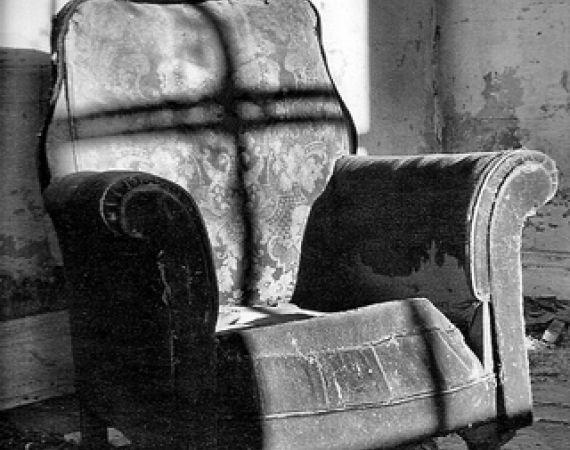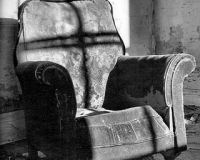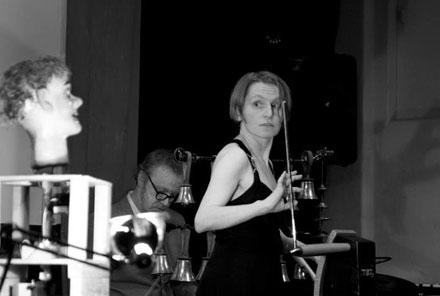Posted on Thu 26 May 2016
More about Sarah and her project plans
Composer, performer and roboticist Sarah Angliss introduces her residency in a little more detail, explaining why she wants to explore poetic approaches to robotics on stage and how she plans to go about it:

Posted by
Project

Trace
Composer, performer and roboticist Sarah Angliss undertakes a part-time residency to explore poetic approaches to robotics on stage:Composer, performer and roboticist Sarah Angliss introduces her residency in a little more detail, explaining why she wants to explore poetic approaches to robotics on stage and how she plans to go about it:
Why explore poetic robotics?
For many years, I’ve been creating robots and automata that can take over certain musical duties on stage. A memorable part of my live set is Hugo, a roboticised 1930s ventriloquist’s dummy head who speaks vocal samples. Another is Wolfgang, a miniature robot drummer in a dapper 1960s suit. And then there’s Clara 2.0, a theremin-playing doll, and The Ealing Feeder, a polyphonic carillon (bell rig) which plays riffs at lightning speed.
 Sarah Angliss performing live Horse Hospital, London (photo Gaynor Perry)
Sarah Angliss performing live Horse Hospital, London (photo Gaynor Perry)
I’m fond of these bandmates and know they have quite an impact on stage—people seems to find them arresting and unsettling. But I’m aware they’re simply 21st century updates of much older forms of human mimicry and musical automation. In this new R&D project, I’ll be taking time out from my usual performance to unpick what this means. For instance, do the robots have an impact, largely because they have historical resonances and human-like features? Or is there scope to create an arresting form of robotics on stage that moves away from these traditional forms? As I consider these questions, I’ll also be trying to devise a more poetic form of robotic performance—one that doesn’t rely on human figures and other traditional tropes.
I want to create a compelling live performance—one that could never be adequately replicated by watching a video or hearing a recording of the event. To this end, I’m striving to create a performance that feels ‘uncanny’, especially when you’re in the same room as me and the robots. The uncanny (das Unheimliche) is that disturbing feeling you get when something seems familiar but strange at the same time. A doll that’s very humanlike might feel uncanny, for example, as we perceive it as something human but inanimate at the same time. Judging by audience feedback, I’d say some of my robots are uncanny. But I have a hunch the uncanny doesn’t require visual human realism. Non-figurative objects can feel uncanny too, if they’re imbued with human animacy. In fact, I made ‘Ventricle’, a blood-red handbag that follows the beats of my own heart, as a first attempt to put this idea to the test.
Project plans
In this R&D project, I’m going to track down furniture, clothing, tools and other discarded possessions, along with their former owners, in Gumtree, jumble sales, ads in shop windows and other places. I’ll roboticise these objects so they mimic the breaths, postural changes, arm movements and other gestures of their former owners. I’ll also pick up sounds from these objects as they move and (where possible) fragments of conversations with their owners, so I can give these inanimate outcasts a rich visual and sonic identity. I’m not trying to ‘cartonify’ the objects so they look like people. Rather than going for realism, I’m seeking something more liminal: the minimum humanlike movement I need to create an impression of human animacy. To capture gestures, breaths and so on, I’ll be using my usual armoury of audio and open-CV style capture methods. I’m also very excited to be meeting experts at the Motion Capture Research Lab at the Academy for Innovation and Research, Falmouth, to learn about the latest motion capture techniques.
I plan to weave together these elements to create Trace, an impressionistic playback of absent persons, using their discarded, former possessions. I’m aiming for a humanistic yet non-figurative form of robotic art that’s distinct from traditional automata and stereotypical metallic sci fi robots. I hope the result will be an uncanny (Unheimlich) and compelling performance—a visitation of sorts.
The residency
This is my first residency. And as an artist concerned with the interplay between live performance and robotics, I can’t think of a better partner to work with than the Pervasive Media Studio, Watershed. I’m looking forward to meeting the other artists and curators there, in particular the magicians currently in residence as I’m sure we have many common interests. I’ll be in Bristol part-time for around 25 days, starting in October 2013. Once I’ve developed Trace, I’m taking it to Vivid, Birmingham, Spirit of Gravity, Brighton, Dorkbot Cardiff and beyond. If you run an arts or tech venue and are interested in hosting a performance of Trace in 2014, do get in touch.
Thanks to the following organisations for making this R&D project possible:
Trace is supported by public funding from the National Lottery through Arts Council England. With additional support from Pervasive Media Studio, Watershed and AIR Falmouth.
About Sarah
Sarah Angliss is a composer, multi-instrumentalist and digital artist, specialising in live electronic music, interactive sound and robotics. She has an unusual combination of skills—in music, electroacoustics and robotics. Sarah is known for her theremin playing, her unusual approach to electronic music (which she uses to explore relationships between technology and European folklore) and for the robots she’s devised and built to accompany her live on stage. Sarah is also a sound historian and her research into the early history of sound technology often informs her compositions and live shows. Sarah performs solo and as part of the human and robot trio Spacedog.
In autumn 2012, Sarah was commissioned by The National Theatre to compose an electronic score for The Effect, Lucy Prebble’s new play. In the last twelve months, Sarah has performed live at the Flatpack Festival, on MS Stubnitz; The Horse Hospital, Brighton Digital Festival; The Bath Festival; Lovebytes, Supersonix, dConstruct and many other events around the UK. She’s also performed live with her robotic instruments on national radio. Sarah recently collaborated with Moon Wiring Club and other artists on Down to the Silver Sea, an album on the Gecophonic label. Her trio Spacedog have just recorded a Study Series collaboration with Belbury Poly for Ghost Box (due for release in October 2013). In May, Sarah was awarded Most Groundbreaking Act of Brighton Festival and Fringe 2013.
